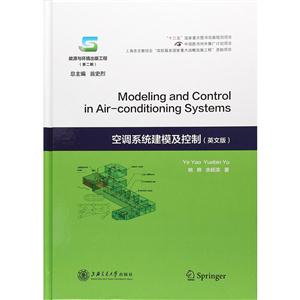-
>
公路車寶典(ZINN的公路車維修與保養秘籍)
-
>
晶體管電路設計(下)
-
>
基于個性化設計策略的智能交通系統關鍵技術
-
>
花樣百出:貴州少數民族圖案填色
-
>
山東教育出版社有限公司技術轉移與技術創新歷史叢書中國高等技術教育的蘇化(1949—1961)以北京地區為中心
-
>
鐵路機車概要.交流傳動內燃.電力機車
-
>
利維坦的道德困境:早期現代政治哲學的問題與脈絡
空調系統建模及控制-(英文版) 版權信息
- ISBN:9787313180803
- 條形碼:9787313180803 ; 978-7-313-18080-3
- 裝幀:一般膠版紙
- 冊數:暫無
- 重量:暫無
- 所屬分類:>>
空調系統建模及控制-(英文版) 本書特色
《空調系統建模及控制(英文版)》主要內容包括:集中空調系統狀態空間建模原理、過程及圖論描述方法,空調系統中傳感器虛擬標定技術及虛擬傳感器模型,雙環路模型預測控制模型,空調負荷組合預測模型,空調系統能量評價分析模型,空氣處理單元機群(AHUs)協同控制模型,以及基于負荷預測的空調系統全局優化節能控制模型。
《空調系統建模及控制(英文版)》內容新穎且信息量大,注重于計算機仿真與實驗相結合以及理論分析和應用實例相結合,是一本建筑環境與設備工程和自動控制學科深度交叉、系統反映新成果的難得的參考書。
《空調系統建模及控制(英文版)》可供從事建筑環境與設備工程、熱能工程、制冷與低溫工程、自動控制工程以及相關專業的本科生和研究生參考使用,也可作為從事相關領域研究的科研人員的參考用書。
空調系統建模及控制-(英文版) 內容簡介
本書是“能源與環境出版工程”之一。本書系統論述了集中空調系統關鍵部件狀態空間模型的建立過程和方法,并通過實驗對各部件狀態空間模型進行了驗證,引入圖論和結構矩陣理論對部件狀態空間模型。本書內容全面、新穎,覆蓋了建筑環境及設備工程領域近期新建模方面的研究成果。該書的主要內容取材于作者的親身研究經歷和工作經驗,具有較高的原創性。
空調系統建模及控制-(英文版) 目錄
1.1 Background
1.2 Modeling Approaches in HVAC Field
1.2.1 Physics-Based Modeling Approach
1.2.2 Data-Driven Modeling Approach
1.2.3 Hybrid Modeling Approach
1.3 Proposed Methods
1.3.1 State-Space Modeling
1.3.2 Graph-Theory Modeling
1.3.3 Combined Forecasting Modeling
1.3.4 Decomposition-Coordination Algorithm for Global Optimization Model
1.3.5 Virtual Calibration for HVAC Sensors
1.3.6 Model-Based Predictive Control (MPC)
1.4 Organization of This Book
References
2 Component Modeling with State-Space Method
2.1 Basic Knowledge about State-Space Modeling Method
2.2 Modeling for HVAC Components
2.2.1 Water-to-Air Heat Exchanger
2.2.2 Chiller
2.2.3 Cooling Tower
2.2.4 Duct (Pipe) and Fan (Pump)
2.2.5 Air-Conditioned Room Modeling
2.3 Modeling for HVAC System
2.3.1 Component Model Connection
2.3.2 State-Space Representation for HVAC System
2.3.3 Case Study
References
3 Dynamic Simulations with State-Space Models
3.1 On Water-to-Air Surface Heat Exchanger
3.1.1 Subjected to Different Perturbations
3.1.2 For Different Initial Conditions
3.2 On Chiller
3.2.1 Subjected to Different Perturbations
3.2.2 For Different Initial Conditions
3.3 On Cooling Tower
3.3.1 Subjected to Different Perturbations
3.3.2 For Different Initial Conditions
3.4 On Duct and Pipe
3.4.1 On Straight-Through Duct
3.4.2 On Straight-Through Pipe
3.5 On Air-Conditioned Room
3.5.1 Basic Conditions
3.5.2 Subjected to Different Perturbations
4 Graph-Theory Modeling and Structure-Matrix Analysis
4.1 Graph-Theory Modeling for HVAC Component State-Space Models
4.1.1 Fundamental Rules
4.1.2 Case Study
4.2 Graph-Theory Modeling for HVAC System
4.2.1 Basic Method
4.2.2 Case Study
4.3 Structure-Matrix Analysis Approach
4.3.1 Model Structural Matrix
4.3.2 Reachability Analysis of Model Input-Output
4.3.3 Controllability/Observability Analysis of Model
4.3.4 Case Study
References
5 Virtual Measurement Modeling
5.1 Virtual Calibration
5.1.1 Conventional Calibration
5.1.2 Methodology of Virtual In Situ Calibration
5.1.3 Case Study
5.2 Virtual Sensing
5.2.1 Development Methodology for Virtual Sensing
5.2.2 Case Study
5.2.3 Model Development
References
6 Control Design Based on State-Space Model
6.1 Model-Based Predictive Control (MPC)
6.1.1 Introduction of MPC
6.1.2 MPC in Broad Definition
6.2 Applications of MPC in HVAC Field
6.2.1 Control of a Hybrid Ventilation Unit
6.2.2 Control of Space Thermal Conditioning
6.3 State-Space Feedback Control System Design
6.3.1 Basic Principle
6.3.2 Control System Design for Water-to-Air Heat Exchanger
6.3.3 MATLAB Simulation of the Control System
6.3.4 Control System Design for Refrigeration System
References
7 Combined Forecasting Models for Air-Conditioning
Load Prediction
7.1 Typical Methods
7.1.1 MLR Modeling
7.1.2 ARIMA Modeling
7.1.3 GM Modeling
7.1.4 ANN Modeling
7.2 Combined Forecasting Model Based on Analytic Hierarchy Process (AHP)
7.2.1 Principles of the Combined Forecasting Method
7.2.2 Determining Weights by Analytic Hierarchy Process (AHP)
7.2.3 Combined Forecasting Model for Hourly Cooling Load Prediction Using AHP
7.3 Forecasting Model Based on Neural Network and Combined Residual Error Correction
7.3.1 Model Development
7.3.2 Case Study
References
8 Energy Analysis Model for HVAC System
8.1 Energy Models for HVAC Components
8.1.1 Chiller
8.1.2 Boiler
8.1.3 Pump and Fan
8.1.4 Cooling Tower
8.1.5 Water-to-Air Heat Exchanger
8.2 Energy-Saving Analysis on VAV Air-Conditioning System
8.2.1 Evaluation Program for Energy Saving of VAV System
8.2.2 Case Study
8.3 Energy Analysis on VAV Air-Conditioning System with Different Air-Side Economizers
8.3.1 Scheme for Air Economizer Cycle
8.3.2 Case Study
References
9 Optimal Control of HVAC System Aiming at Energy Conservation
9.1 Air-Side Synergic Control
9.1.1 Background and Basic Idea
9.1.2 Mathematic Deduction of Synergic Control Model
9.1.3 Control Logic Details
9.1.4 Case Study
9.2 Global Optimization Control
9.2.1 Model Development
9.2.2 Decomposition-Coordination Algorithm for Model Solution
9.2.3 Case Study
Appendix
References
10 Modeling and Control Strategies for VAV Systems
10.1 Background and Research Status
10.2 Modular Modeling with Simulink Tool
10.3 Model Library for Components of VAV System
10.3.1 VAV Terminal Unit
10.3.2 Variable Speed Fan
10.3.3 Air Ducts
10.3.4 Other Local Resistance Components
10.3.5 Application of Component Model Library: Case Study
10.4 Control Strategies for VAV System
10.4.1 Constant Static Pressure Method
10.4.2 Total Air Volume Method
10.4.3 Variable Static Pressure Method Based on Trim-and-Respond Logic
10.5 Control Sequences for VAV System with Different Terminal Units
10.5.1 For Cooling-Only Terminal Unit
10.5.2 For Reheat Terminal Unit
10.5.3 For Series Fan-Powered Terminal Unit
10.6 Test Script for VAV Control Study
10.6.1 Preparation
10.6.2 General Inspection of Air-Handling and Distribution System
10.6.3 Trend Data Review
References
- >
煙與鏡
- >
我與地壇
- >
李白與唐代文化
- >
我從未如此眷戀人間
- >
隨園食單
- >
月亮虎
- >
朝聞道
- >
小考拉的故事-套裝共3冊














